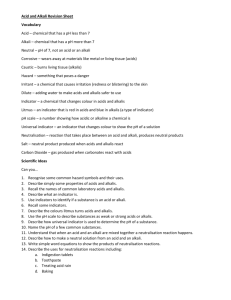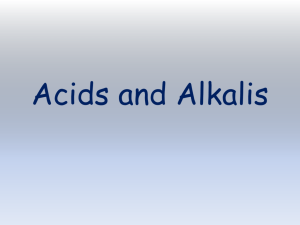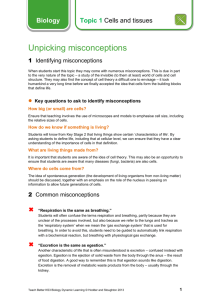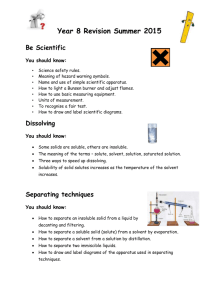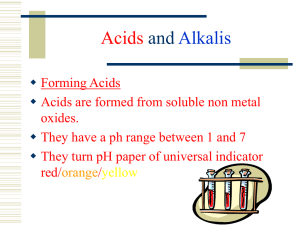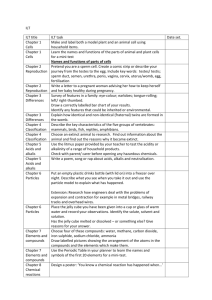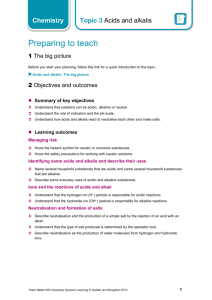Acids and alkalis - Dynamic Learning from Hodder Education
advertisement
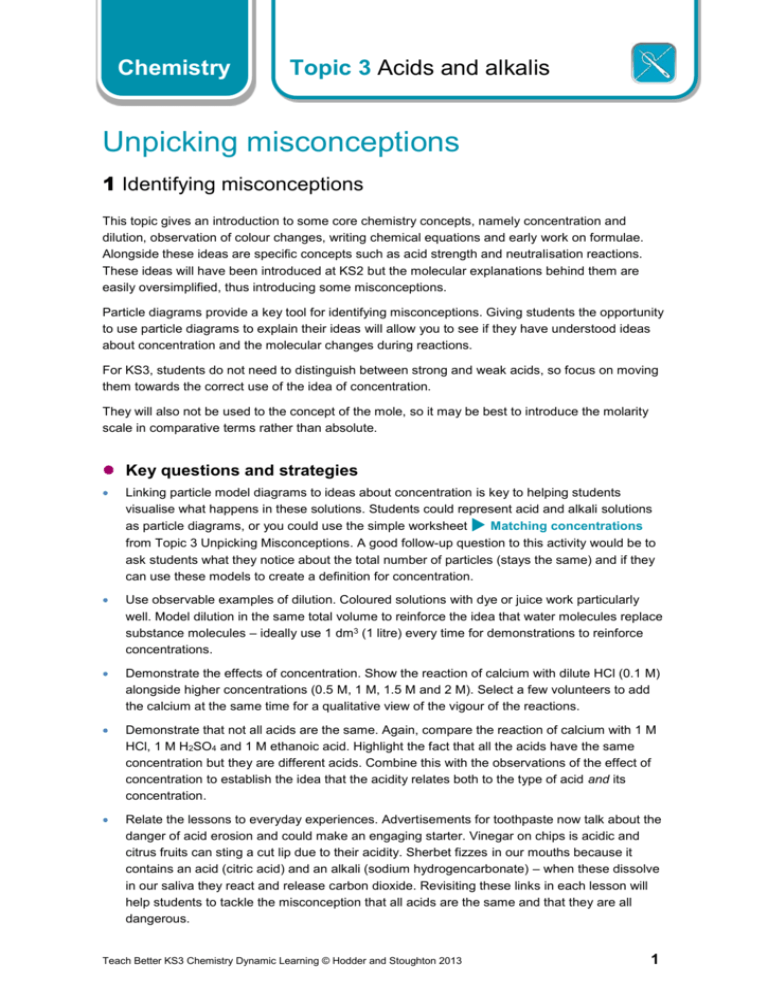
Chemistry Topic 3 Acids and alkalis Unpicking misconceptions 1 Identifying misconceptions This topic gives an introduction to some core chemistry concepts, namely concentration and dilution, observation of colour changes, writing chemical equations and early work on formulae. Alongside these ideas are specific concepts such as acid strength and neutralisation reactions. These ideas will have been introduced at KS2 but the molecular explanations behind them are easily oversimplified, thus introducing some misconceptions. Particle diagrams provide a key tool for identifying misconceptions. Giving students the opportunity to use particle diagrams to explain their ideas will allow you to see if they have understood ideas about concentration and the molecular changes during reactions. For KS3, students do not need to distinguish between strong and weak acids, so focus on moving them towards the correct use of the idea of concentration. They will also not be used to the concept of the mole, so it may be best to introduce the molarity scale in comparative terms rather than absolute. Key questions and strategies Linking particle model diagrams to ideas about concentration is key to helping students visualise what happens in these solutions. Students could represent acid and alkali solutions as particle diagrams, or you could use the simple worksheet Matching concentrations from Topic 3 Unpicking Misconceptions. A good follow-up question to this activity would be to ask students what they notice about the total number of particles (stays the same) and if they can use these models to create a definition for concentration. Use observable examples of dilution. Coloured solutions with dye or juice work particularly well. Model dilution in the same total volume to reinforce the idea that water molecules replace substance molecules – ideally use 1 dm3 (1 litre) every time for demonstrations to reinforce concentrations. Demonstrate the effects of concentration. Show the reaction of calcium with dilute HCl (0.1 M) alongside higher concentrations (0.5 M, 1 M, 1.5 M and 2 M). Select a few volunteers to add the calcium at the same time for a qualitative view of the vigour of the reactions. Demonstrate that not all acids are the same. Again, compare the reaction of calcium with 1 M HCl, 1 M H2SO4 and 1 M ethanoic acid. Highlight the fact that all the acids have the same concentration but they are different acids. Combine this with the observations of the effect of concentration to establish the idea that the acidity relates both to the type of acid and its concentration. Relate the lessons to everyday experiences. Advertisements for toothpaste now talk about the danger of acid erosion and could make an engaging starter. Vinegar on chips is acidic and citrus fruits can sting a cut lip due to their acidity. Sherbet fizzes in our mouths because it contains an acid (citric acid) and an alkali (sodium hydrogencarbonate) – when these dissolve in our saliva they react and release carbon dioxide. Revisiting these links in each lesson will help students to tackle the misconception that all acids are the same and that they are all dangerous. Teach Better KS3 Chemistry Dynamic Learning © Hodder and Stoughton 2013 1 Chemistry • Topic 3 • Acids and alkalis 2 Common misconceptions Students will use the term strong/weak and concentrated/dilute to mean the same thing. This idea is embedded in earlier teaching and many textbooks refer to strong and weak acids. This is not incorrect, but the texts do not cover the concept that a strong acid can be diluted and in doing so the pH value will increase to near neutral. A more concentrated solution of a weak acid could, therefore, have a lower pH. An acid’s strength is a measure of how easily the acid dissociates (gives up its hydrogen). This is a concept met late in KS4. If concentration is equal, a stronger acid will have a lower pH and greater acidity (pH itself being a measure of the concentration of hydrogen ions in the solution). Concentration is a much more useful and relevant concept for KS3 and the best way to tackle the misconception is to only use the terms concentrated and dilute and never describe acids or alkalis in terms of strong or weak. ‘Dilution is a process of making something weaker.’ This misconception is supported by everyday experiences such as making orange squash. Students will perceive the action in a qualitative way using colour to judge the amount of water to add. You can build on this by encouraging students to draw particle diagrams of the squash, asking them if the juice particles have changed in any way (which they have not) and guiding them to the idea that dilution is a replacement of the chemical particles with water particles. The observable effect is a paler colour simply because there are fewer juice particles in the same volume. This will help them to understand dilution when using colourless acidic solutions, where there are no visual cues. ‘Acids and alkalis are dangerous.’ Students are told this at KS2 and we reinforce this by emphasising the safety precautions in the laboratory when dealing with acids. To address this misconception allow student to discuss the relative danger. Many household items are acids and alkalis and are used every day. Highlight the need for eye protection in the laboratory – here we work with substances of different concentration, so we need to be protected if even one of those is hazardous. Students often confuse the concepts of neutralisation and dilution. They may express the idea that neutralisation makes an acid safer, missing the idea that whilst an exact quantity of alkali added to an acid will indeed neutralise the solution, any additional quantities added will take the pH away from neutral. Some students will suggest that if acid is spilt on skin a good idea would be to add an alkali to neutralise it. This must be addressed for safety purposes and an explanation given for why washing immediately in running water is a much safer approach. This will dilute the acid or alkali to a safe pH. Teach Better KS3 Chemistry Dynamic Learning © Hodder and Stoughton 2013 2 Chemistry • Topic 3 • Acids and alkalis ‘Adding an acid solution to an alkali solution will make a neutral salt solution.’ Whilst this is true with careful calculation and accurate measurement and mixing, more often either the acid or alkali will be in excess. Therefore the resulting solution will contain a salt but it will also contain whichever solution is in excess. Without the addition of an indicator or use of a probe it is not possible to know the final pH. From a safety perspective the salt solution must be treated with caution, as will any final salt crystals produced, as these will be contaminated. At KS4 students will investigate practical procedures needed to make pure samples of salt crystals. Addressing these ideas at KS3 will help them make sense of this later. 3 Overcoming the big misconceptions In Topic 3 Unpicking Misconceptions you will find presentations on overcoming two major misconceptions. Once you have watched the presentation, you can use the content of the slides to work through the misconceptions with your students. Misconception 1: Concentration of an acid Misconception 2: Neutralisation Teach Better KS3 Chemistry Dynamic Learning © Hodder and Stoughton 2013 3

